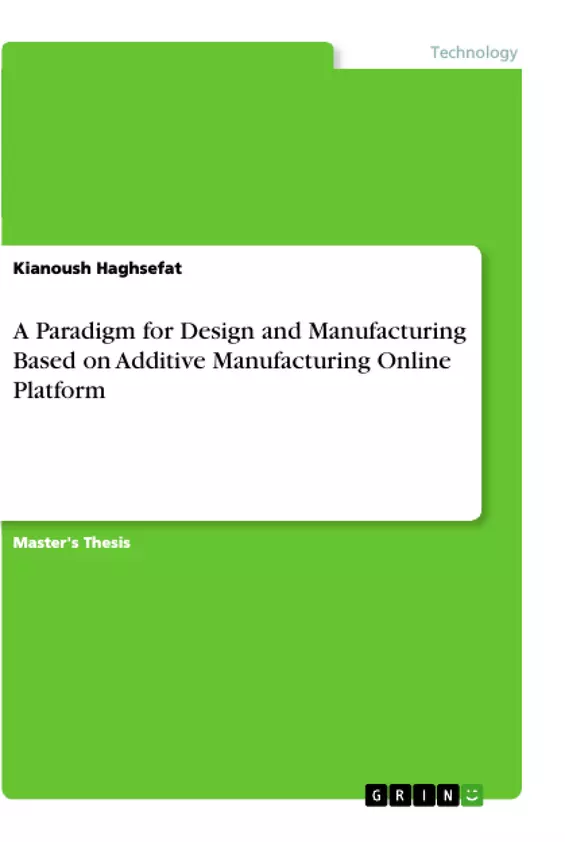This paper applies the 3D printing industry to the cloud manufacturing model and takes as its research goal the collaborative design and manufacturing paradigm in the intelligent platform of additive manufacturing. The system design and key technologies of the additive manufacturing intelligent cloud platform are systematically analyzed on the basis of the cloud manufacturing concept. A prototype device has been developed.
The paper's key primary research is as follows: Combined with the concept and context of cloud 3D manufacturing, the research status of cloud manufacturing was analyzed, the description and benefits of cloud manufacturing were systematically summarized, the general structure of 3D printing cloud platform services was developed, and the module functions, application methods, and operating mechanisms were introduced. An eight-layer architecture of the cloud platform is proposed based on the functional framework of the 3D printing cloud platform. Several key modules of the online cloud platform are analyzed and clarified, and through a comparative comparison with the conventional 3D printing network platform, the benefits of the 3D printing cloud platform are examined.
The 3D printing cloud platform development environment was created, the prototype system data sheet was designed, and the prototype system of the 3D printing cloud platform was developed. The prototype system's key functional modules are evaluated, and the prototype system's functional pages are explained. VIII Finally, the study findings of this article are summarized, and further study work is suggested. 3D printing, as an important part of advanced manufacturing technology, will compensate for the manufacturing needs of complex components in many industries and fulfill the rising customized manufacturing needs of people. The growth of the domestic 3D printing industry is relatively slow due to the lack of a robust service model. Cloud manufacturing is a modern paradigm of intelligent, effective and service-oriented production that has been proposed in recent years.
Inhaltsverzeichnis (Table of Contents)
- Zusammenfassung (Summary)
- Abstract
- 1 Einleitung (Introduction)
- 2 Literaturüberblick (Literature Review)
- 3 Forschungsmethodik (Research Methodology)
- 4 Ergebnisse und Diskussion (Results and Discussion)
- 5 Schlussfolgerungen und Ausblick (Conclusions and Outlook)
- Literaturverzeichnis (Bibliography)
Zielsetzung und Themenschwerpunkte (Objectives and Key Themes)
This dissertation explores the development of a collaborative design and manufacturing paradigm for additive manufacturing, based on the concept of cloud manufacturing. The work focuses on the application of cloud manufacturing principles to the 3D printing industry, aiming to address the limitations of traditional service models and foster the growth of the domestic 3D printing sector.
- Cloud manufacturing and its application to 3D printing
- The development of a collaborative design and manufacturing paradigm
- System architecture and key technologies of the additive manufacturing intelligent cloud platform
- Development of a prototype system for the 3D printing cloud platform
- Evaluation of the benefits and advantages of the proposed cloud platform
Zusammenfassung der Kapitel (Chapter Summaries)
- Chapter 1: Introduction This chapter introduces the concept of additive manufacturing (3D printing) and its potential within the industry. It emphasizes the need for a robust service model to facilitate the growth of the domestic 3D printing industry. The chapter also introduces the concept of cloud manufacturing as a potential solution for this challenge.
- Chapter 2: Literature Review This chapter presents a comprehensive review of existing research on cloud manufacturing, 3D printing, and the integration of these technologies. It analyzes the current state of the art in these fields and identifies key challenges and opportunities.
- Chapter 3: Research Methodology This chapter outlines the research methods and methodologies used in this dissertation. It explains the approach taken for the development of the cloud platform, the design of the prototype system, and the evaluation of its functionalities.
- Chapter 4: Results and Discussion This chapter presents the results of the research, including the design and implementation of the cloud platform. It analyzes the key features and functionalities of the platform, as well as its performance and effectiveness in supporting collaborative design and manufacturing processes.
Schlüsselwörter (Keywords)
This dissertation focuses on the keywords and concepts related to 3D printing, cloud manufacturing, cloud platform, resource and task modeling, and collaborative design and manufacturing. It explores the potential of cloud manufacturing to address the challenges of traditional 3D printing service models and facilitate the development of a collaborative design and manufacturing paradigm.
- Citar trabajo
- Kianoush Haghsefat (Autor), 2021, A Paradigm for Design and Manufacturing Based on Additive Manufacturing Online Platform, Múnich, GRIN Verlag, https://www.grin.com/document/1014086



